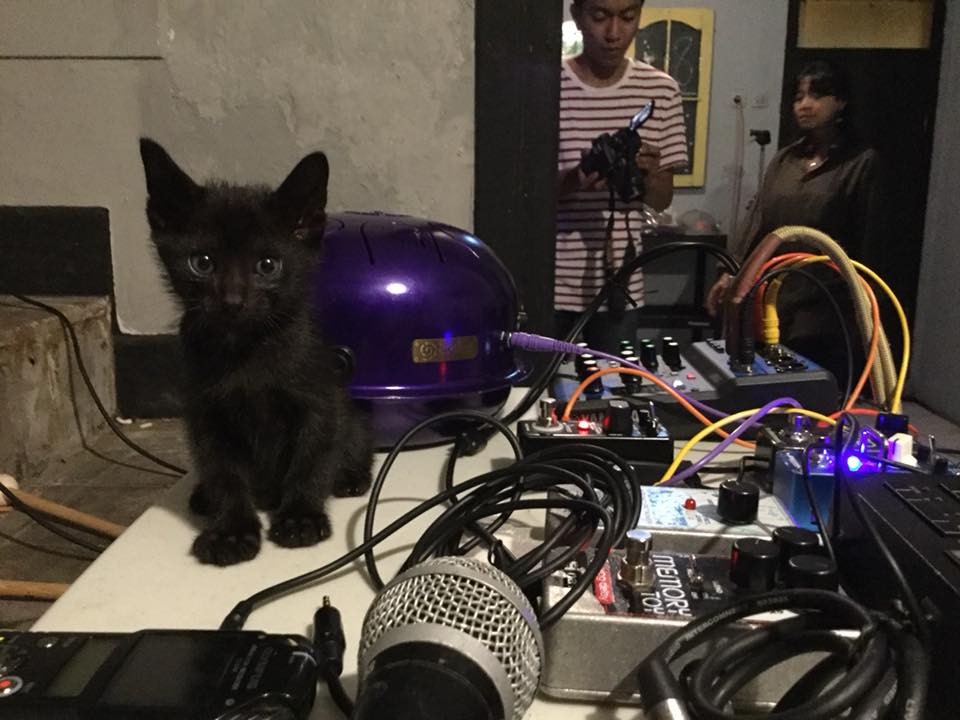
Adorable black kitten with sundry electronics and a garrahand drum – and a purple one to boot 💜
From our friend Robert L Pepper of Pas Musique
From my gig in Bandung, Indonesia last night.

As we busily prepare for the next Vacuum Tree Head show this coming Tuesday, I find myself looking back at my last show with a very different band, Manul Override earlier this month at the Make-Out Room in San Francisco. It was the subject of a recent CatSynth TV episode.
The evening began with an improvised set featuring saxophonist David Pate with keyboardist Steve Cohn.
Then it was time for Manul Override’s debut show. This was a new group I put together with my friend and collaborator Serena Toxicat on voice and former Surplus-1980 bandmate Melne on guitar.
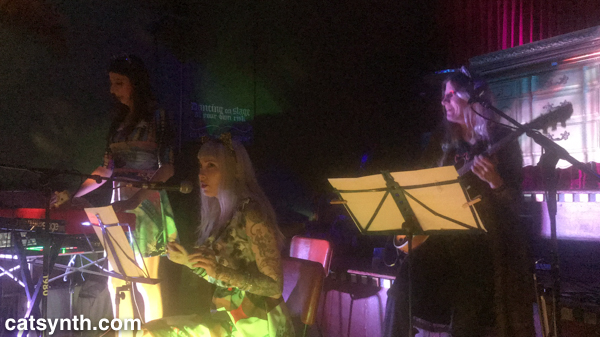
We had a lot of fun on stage, and the energy spread to the audience, with dancing and meowing all around (all of our tunes had at least some connection to cats). I was particularly happy with the opening incantation, which featured a French rendition of Serena’s ode to the goddess Bast, and our 1980s-pop-style tune “Goodnigobbles”, which also featured Serena seductively delivering lyrics and spoken words in French. Melne had a chance to show her versatility throughout the set, including our extended funky jam in the middle of the set. As with all new musical projects, this is a work in progress, figuring out what works for us and what doesn’t, and how to make each show better than the previous one. But it was also fun visually, with our fashion statements, cat ears, and Melne’s lighting.
The final set featured Ornettology, a project led by guitarist and composer Myles Boisen. As the name suggests, the group is inspired by the music of Ornette
The band delivered a truly dynamic performance that featured some of Ornette Coleman’s more familiar tunes, including “Ramblin'” and “Mob Job” There were some great solos from each of the members of the group as well. You can hear some of Philip Greenlief and Myles Boisen soloing in our video.
The last few shows I have played at the Make-Out room always have a great audience – full houses that seem to appreciate having live music, whether they came to hear the specific artists or just happened to drop by. A few in the latter category seemed to quite enjoy our Manul-Override set, signing Serena’s leg cast (she had an unfortunate accident a couple of weeks before the show) and taking selfies with us. It was a fun night of music all aroundl.
Handsome Marcel returns, and enjoys participating in a modular-synth session with his human polynominal. Both are longtime friends of CatSynth and you can see their previous posts here.
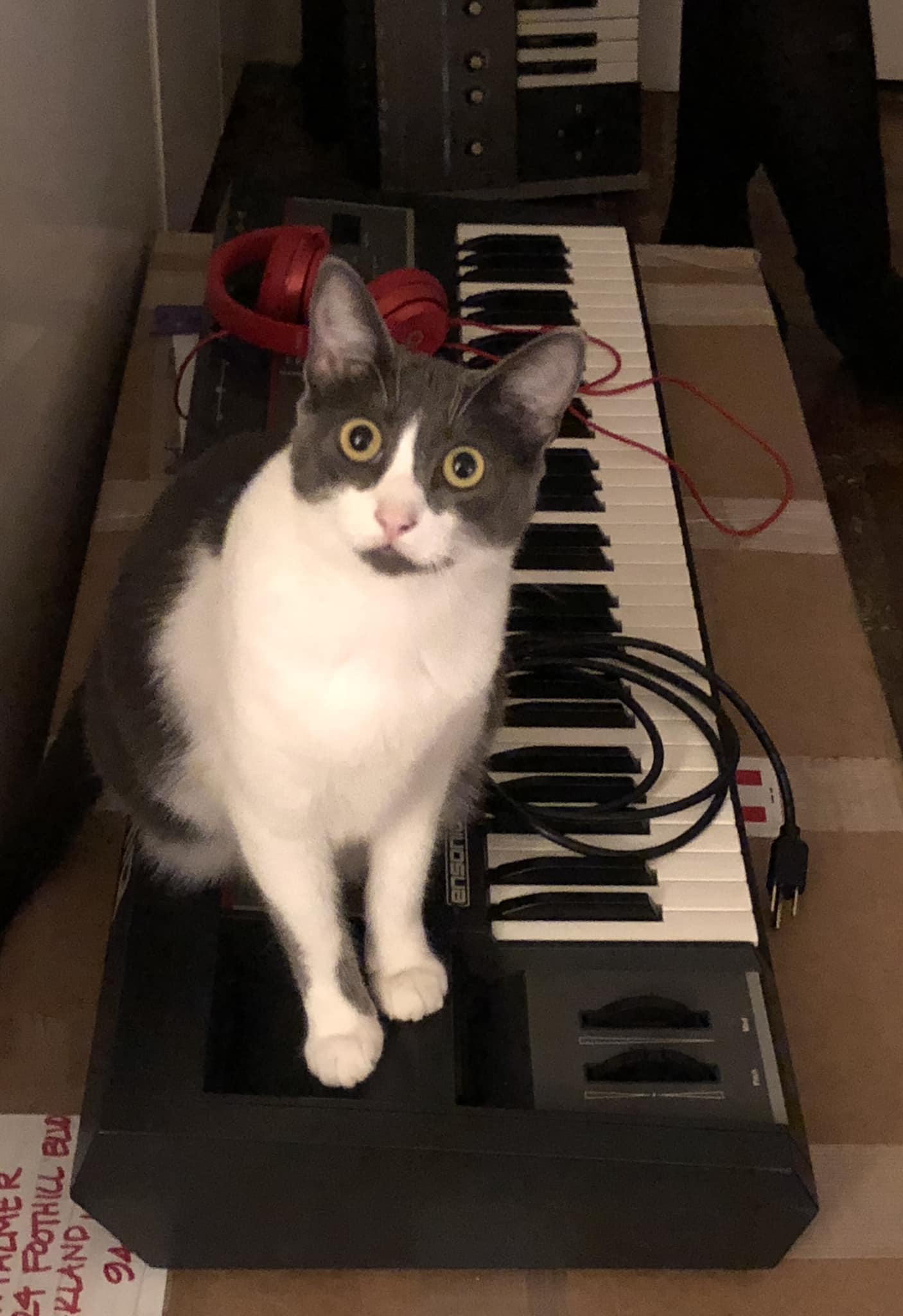
Gracie is back! This time with an Ensoniq SQ-80 synthesizer. From Alsún Ní Chasaide (Alison Cassidy) via Facebook.
It seems that Gracie really likes this particular synth 😸
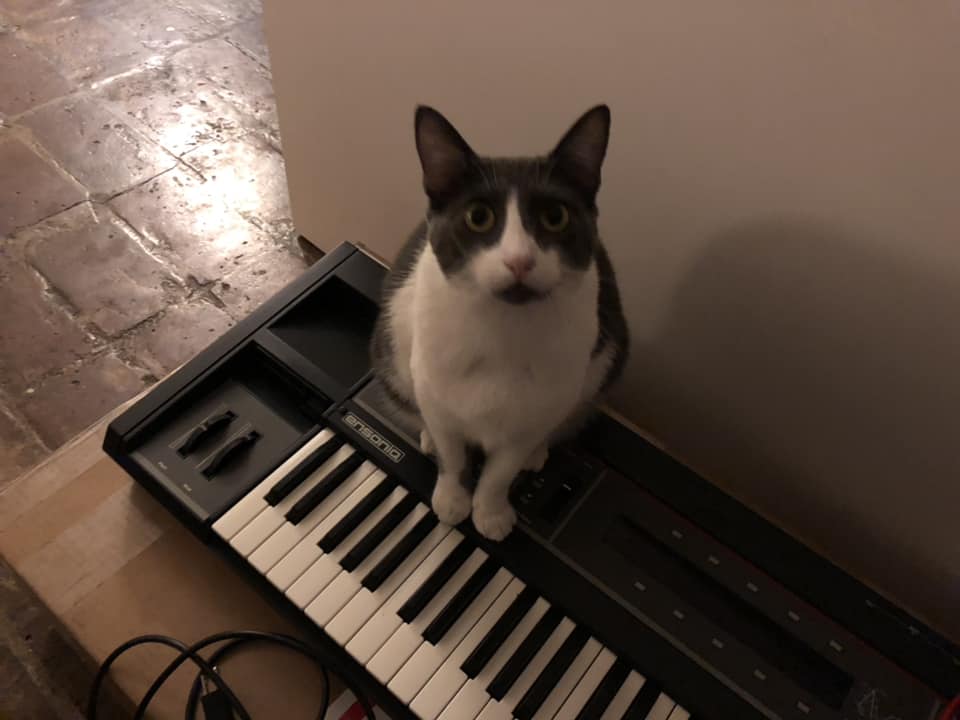

The SQ-80 is an interesting synth that came out about the same time as the Ensoniq EPS (which along with its successor the ASR-10 were mainstays of my studio until about 2000). From Vintage Synth Explorer:
The SQ-80 is basically a reved-up ESQ-1 with a total of 75 waveforms, a 61-note keyboard with velocity & aftertouch, floppy disk drive for storing patches and sequences, and an enhanced sequencer. Great for organs, analog-type sounds, pads and sound effects. Like the classic ESQ-1, the SQ-80 functions in providing analog-type 4-pole lowpass filtering and editing of digital waveforms. Each voice can combine up to 3 of the 75 waveforms. These waveforms include multi-sampled transient attack waves such as violin bow, plectrum picks, mallet, hammer, breath attacks and percussive sounds. There are also 5 sampled drum sets. Three LFOs are onboard for some pretty wild modulation of the sounds you create or edit.
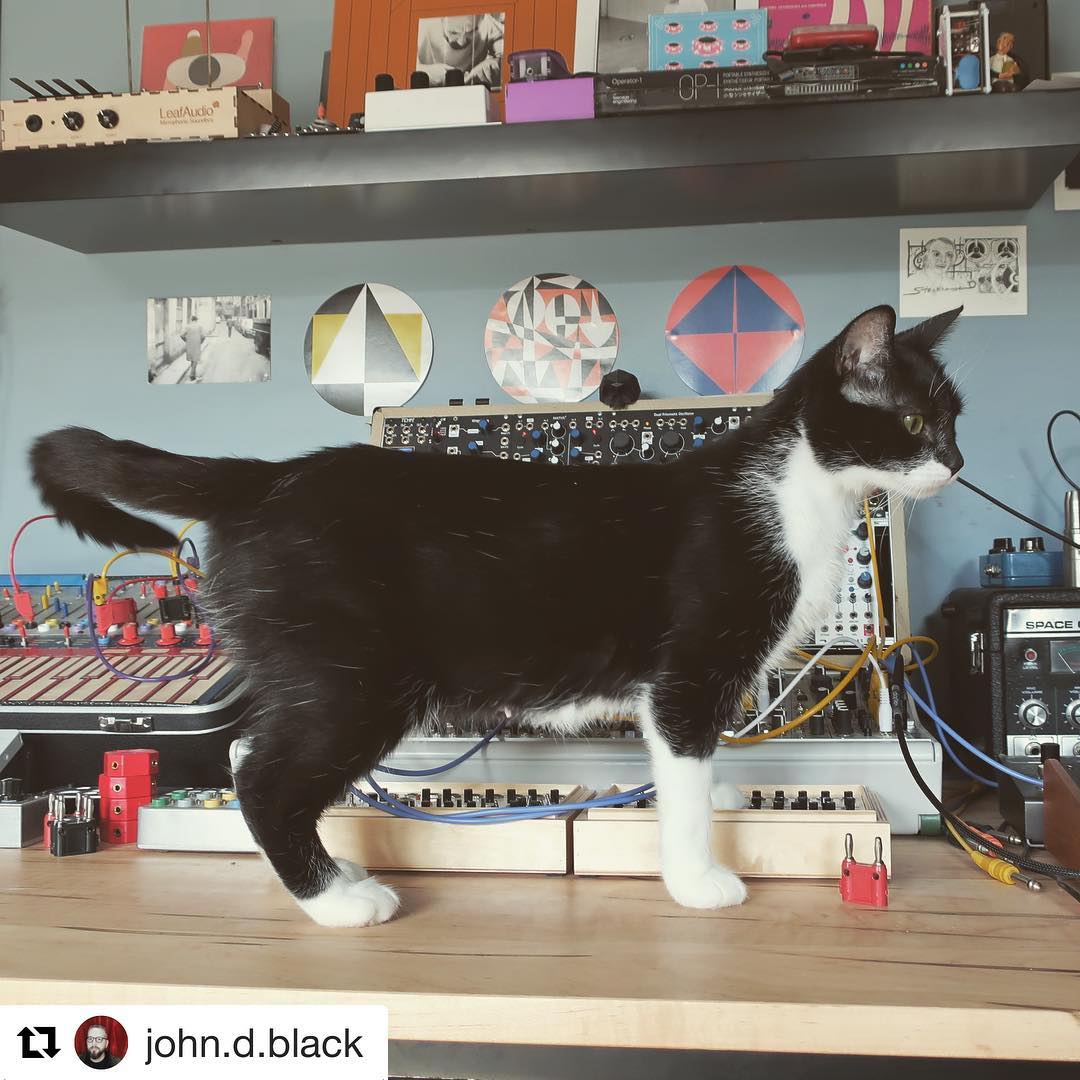
This cat knows how to frame his poses purrfectly 😸
Most of the modular is obscured by this cutie, but we do espy a pair of KOMA Field Kits, as well as a Buchla Music Easel.
From catsofmodular on Instagram.
We at CatSynth have been extraordinarily busy since the start of summer with work, music, and other obligations. As a result, our explorations of visual art have suffered a bit. But we start correcting that today with a report from the blockbuster René Magritte: The Fifth Season exhibition at SFMOMA. I’m glad I was able to get in to see it before it closes in two weeks!
The exhibition focuses on his later works, from World War II through the late 1960s. It is billed as “If you think you know Magritte (1898–1967), think again.” Yet, this period includes many of his most iconic works – other than perhaps his most famous La Trahison des images (aka “this is not a pipe”), including many of my favorites from the broader Magritte retrospective I had seen at SFMOMA in the early 2000s.
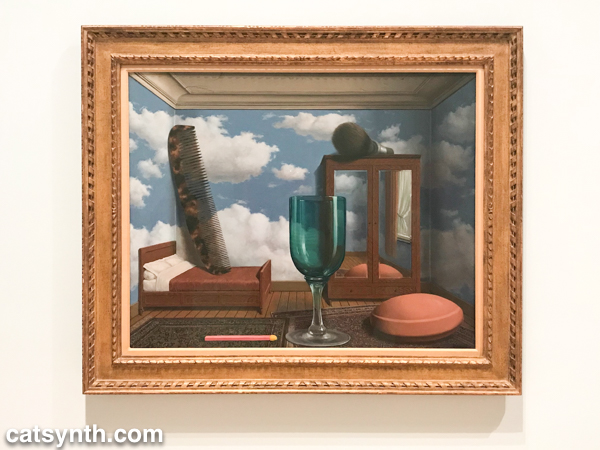
The work depicted above, Les valeurs personnelles, is perhaps my favorite of all. I find myself drawn to it not just because of the stark juxtaposition of larger-than-human-sized objects in a smaller-than-human-sized space, but for the various textures that defy painting. The objects themselves have the hyperrealistic sheen of graphics from the 1990s (we were all proud of our ability to render glass) with the more pedestrian room space and strangely realistic sky on the wall. These are the characteristics of many of Magritte’s pieces during his Hypertrophy period in the 1950s. It’s taken to an extreme in a piece that features one of his iconic green apples swelling to gargantuan proportions and pushing against the walls of a modest room.

And of course, there were many bowler-hatted gentlemen, some with green apples, some without.
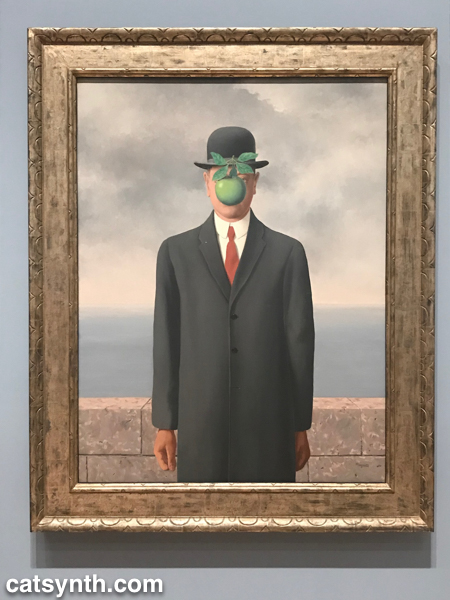
The image of the bowler hat and the bowler-hatted man has appeared throughout Magritte’s career, but it was more closely associated with the artist himself in his later works, a form of
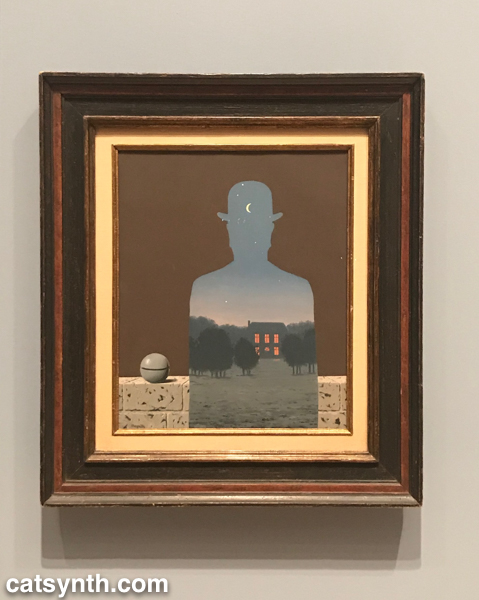
In addition to the green apple, we see many objects and concepts that appear in other works from this period applied to the bowler-hatted man, such as the small round stone, birds, and negative spaces.
In both sets of works, we see the discrete juxtaposition of elements that may or may not fit with real-life experience. I see this is as “quintessentially Magritte” and consistent throughout most of his career. In that sense, I disagree a bit with the thesis of the exhibition that this later period was a break with surrealism, but rather a reimagining of it with different subjects and techniques and without the heaviness of the
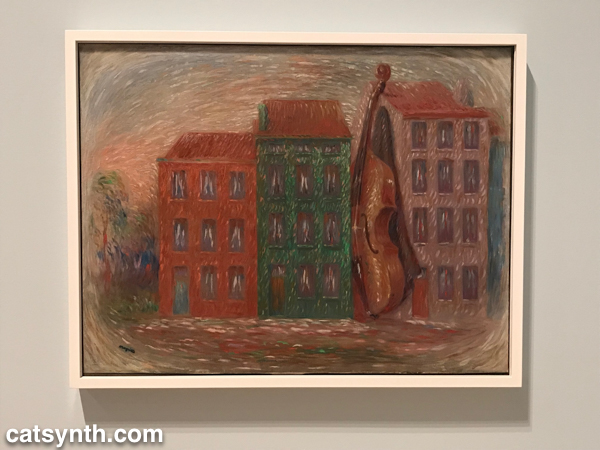

I would never have guessed these grotesque parodies of van-Gogh-style impressionism were his work if they were not presented and explained. At the same time, it is not surprising that the experience of the war (Magritte remained in his native Belgium during the Nazi occupation). It feels like his weakest and least memorable work, but one theory suggests that his retrograde style during this period helped avoid Nazi attention and persecution. We are certainly glad he returned to form in his later years.
One of late series, collectively called The Dominion of Light, brings together a nighttime city streetscape with a daytime sky.

It takes a moment of adjustment to realize the confounding of night and day in the image, as our eyes are so used to assumptions about the passing of time and light. The series is at once playful, but also a bit melancholy, pointing to the later years of a life and life’s work. Fortunately, there was one more chapter to come that was both more curious and more
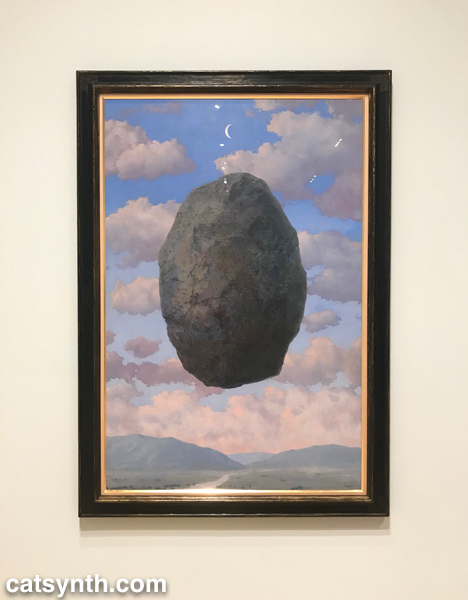
This bizarre series of boulders floating in space or sitting isolated on an apartment terrace is a return to form, but also an exploration of time and gravity and even more fundamental assumptions that we make in everyday life. Their lightness and starkness also make an interesting statement at the end of a career that spanned several decades and saw the massive changes of the 20th century. We should note that the bowler-hat portraits featured in this article were done during the same late period, and are stronger both as works in themselves and as a career-spanning statement.
The exhibit was overall a delight to experience. It was hung in a minimalist but also warm style without too much crowding or overwhelm, and it weaved a narrative even as I took in the works as individuals. It also marked a return a place of solace, the museum, after a long period of intensity and focus on other practices. I won’t stay away as long again.
If you are in San Francisco over the next couple of weeks, I strongly recommend checking this exhibition out before it closes on October 28. For more information, please visit https://www.sfmoma.org/exhibition/rene-magritte/.